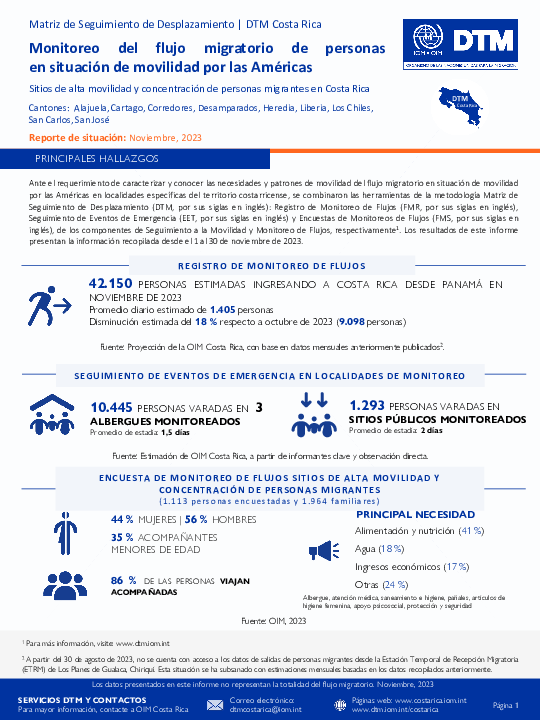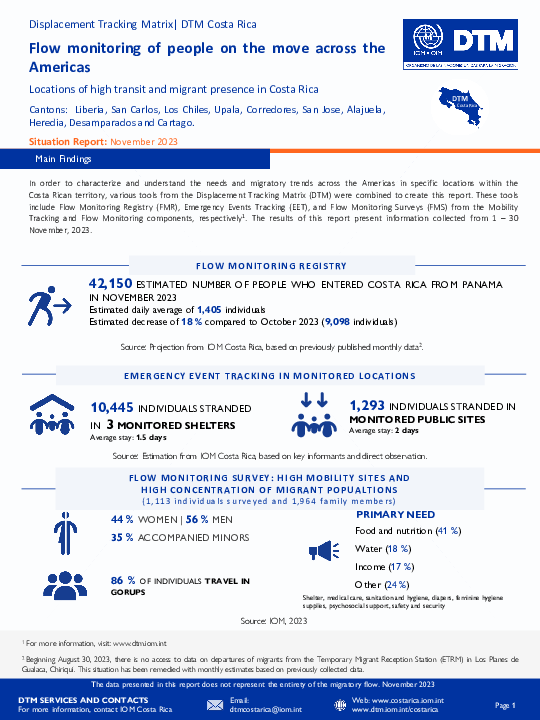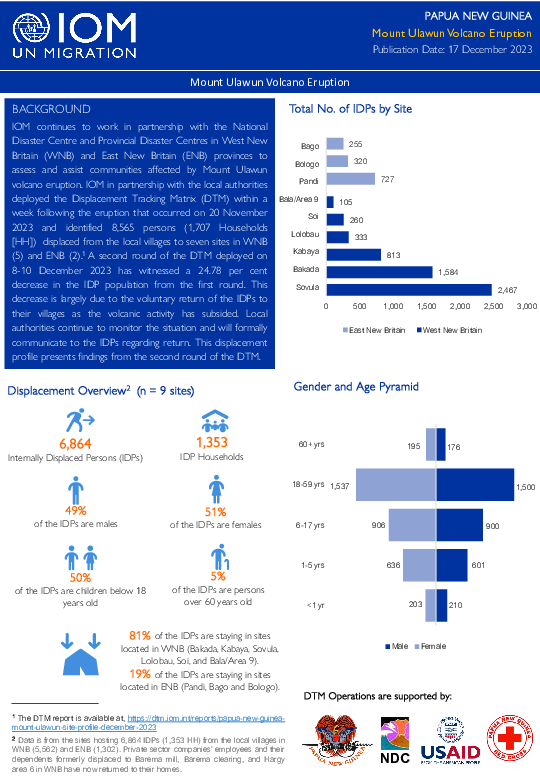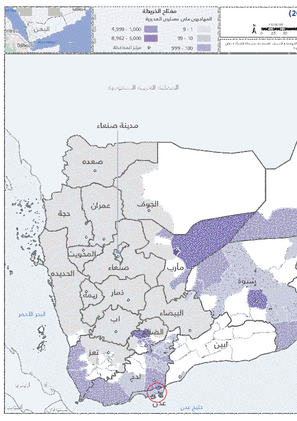-
Countries
-
Data and Analysis
-
Special Focus
-
Crisis Responses
Contact
dtmlebanon@iom.int
Location
Lebanon
Activity
- Mobility Tracking
- Baseline Assessment
Period Covered
Oct 10 2023 -Dec 12 2023
SHARE ShareFacebookTwitterLinkedInEmailWhatsApp Contact dtmlebanon@iom.int Location Lebanon Activity Mobility Tracking Baseline Assessment Period Covered Oct 10 2023 - Dec 05 2023 Since October 8 there has been an increase in cross-border incidents between Israel and Lebanon, resulting in the displacement of people both within the South and elsewhere within the country. Since October 10, the Displacement Tracking Matrix (DTM) has been conducting the daily monitoring of population movements. The objective of the exercise is to inform preparedness and response planning.
Aggregated data is available through the DTM API: https://dtm.iom.int/data-and-analysis/dtm-api
A more detailed version of this dataset is available, to get access kindly click on the 'Request Access' button
Population Groups
IDPs
Survey Methodology
Unit of Analysis Or Observation
Admin Area 2
Admin Area 3
Household
Individual
Type of Survey or Assessment
Key Informant
Keywords
Geographical Scope Full Coverage
Administrative boundaries with available data
The current dataset covers the following administrative boundaries

Contact
DTMCostaRica@iom.int
Language
English
Location
Costa Rica
Period Covered
Nov 01 2023
Nov 30 2023
Activity
- Flow Monitoring
- Mobility Tracking
- Event Tracking
Cantones: Alajuela, Cartago, Corredores, Desamparados, Heredia, Liberia, Los Chiles, San Carlos, San José.
Costa Rica, al igual que los demás países de la región centroamericana, se ha caracterizado por ser un corredor migratorio para personas que transitan de manera terrestre desde el sur hasta el norte de América y que tienen como destino los países del norte del continente. Este flujo en situación de movilidad por las Américas se encuentra compuesto principalmente por personas de la República Bolivariana de Venezuela, Cuba, Haití, Ecuador, así como personas provenientes de otros países de Suramérica, África y Asia.
Según estimaciones de la OIM Costa Rica, durante noviembre ingresaron al país 42.150 personas, un promedio de 1.405 personas por día y estimando una disminución de un 18% con respecto a octubre de 2023. Además, se identificaron 10.445 personas varadas en los albergues monitoreados y 1.293 personas varadas en los sitios públicos visitados.

Contact
DTMCostaRica@iom.int
Language
English
Location
Costa Rica
Period Covered
Nov 01 2023
Nov 30 2023
Activity
- Flow Monitoring
- Mobility Tracking
- Event Tracking
Cantons: Alajuela, Cartago, Corredores, Desamparados, Heredia, Liberia, Los Chiles, San Carlos, San José.
Costa Rica, like the other countries in the Central American region, has been characterized as a migratory corridor for people who transit by land from the south to the north of America and whose destination is the countries in the north of the continent. This flow on the move through the Americas is mainly made up of people from the Bolivarian Republic of Venezuela, Cuba, Haiti, Ecuador, as well as people from other countries in South America, Africa and Asia.
According to estimations from IOM Costa Rica, during October 42.150 people entered the country, an average of 1,405 people per day and estimating a decrease of 18% compared to October 2023. In addition, 10,445 people stranded in the monitored shelters were identified and 1,293 people stranded in the public places visited.

Contact
DTM Iraq, IraqDTM@iom.int
Language
English
Location
Iraq
Period Covered
May 01 2023
Aug 31 2023
Activity
- Mobility Tracking
- Baseline Assessment
Since 2014, the International Organization for Migration’s (IOM) Displacement Tracking Matrix (DTM) unit in Iraq has collected information on internally displaced persons (IDPs) and returnees using a network of key informants across the country.1 Data for this round were collected from 1 May to 31 August 2023.

Contact
DTMUkraine@iom.int
Language
English
Location
Ukraine
Period Covered
Sep 03 2023
Sep 25 2023
Activity
- Survey
As of November 2023, Ukraine is facing not only the immediate impact of conflict but also the ensuing challenges as the country entered the winter months. The situation has brought to the forefront issues related to heating, housing, winter-related needs and the ability to withstand the harsh winter conditions.
This brief presents insights into winterization preparedness, encompassing aspects such as access to heating, the adequacy of housing for winter conditions, and the specific winter-related needs of the population. These findings come from the General Population Survey (GPS), the Solid Fuel Assessment (SFA) and the Mobility and Needs Assessment (MaNA). The aim is to guide the humanitarian response stakeholders in formulating and implementing targeted winterization strategies.

Contact
DTM Papua New Guinea, iompngmdac@iom.int
Language
English
Location
Papua New Guinea
Period Covered
Dec 08 2023
Dec 10 2023
Activity
- Mobility Tracking
- Baseline Assessment
IOM continues to work in partnership with the National Disaster Centre and Provincial Disaster Centres in West New
Britain (WNB) and East New Britain (ENB) provinces to assess and assist communities affected by Mount Ulawun
volcano eruption. IOM in partnership with the local authorities deployed the Displacement Tracking Matrix (DTM) within a
week following the eruption that occurred on 20 November 2023 and identified 8,565 persons (1,707 Households [HH]) displaced from the local villages to seven sites in WNB (5) and ENB (2). 1 A second round of the DTM deployed on
8-10 December 2023 has witnessed a 24.78 per cent decrease in the IDP population from the first round. This
decrease is largely due to the voluntary return of the IDPs to their villages as the volcanic activity has subsided. Local
authorities continue to monitor the situation and will formally communicate to the IDPs regarding return. This displacement
profile presents findings from the second round of the DTM.
Contact
DTM Yemen, iomyemendtm@iom.int
Location
Yemen
Activity
- Rapid Emergency Registration
- Mobility Tracking
- Event Tracking
Period Covered
Dec 10 2023 -Dec 16 2023
From 1 January to 16 December 2023, IOM Yemen DTM tracked 9,836 households (HH) (59,016 Individuals) who experienced displacement at least once.
Between 10 and 16 December 2023, IOM Yemen DTM tracked 50 households (300 individuals) displaced at least once. The majority of people moved into/within the following governorates and districts:
- Ta’iz (23 HHs) – Al Makha (20 HHs), As Silw (3 HHs) districts. Most displacements in the governorate originated from Taiz and Al Hodeidah.
- Ma’rib (22 HHs) – Marib City (14 HHs), Marib (8 HHs) districts. Most displacements in the governorate originated from Taiz and Hajjah.
- Al Hodeidah (5 HHs) – Hays (5 HHs) district. All displacements in the governorate originated from Taiz.
The majority of people moved from the following governorates and districts:
- Ta’iz (23 HHs) – Maqbanah (10 HHs), Jabal Habashi (4 HHs), Al Mudhaffar (3 HHs) districts.
- Al Hodeidah (7 HHs) – Hays (5 HHs), Al Qanawis (1 HHs), Al Jarrahi (1 HHs) districts.
- Hajjah (4 HHs) – Harad (1 HHs), Kuaydinah (1 HHs), Kushar (1 HHs) districts.
Population Groups
Survey Methodology
Unit of Analysis Or Observation
Type of Survey or Assessment
Keywords
Geographical Scope
Administrative boundaries with available data
The current dataset covers the following administrative boundaries
تُظهر هذه الخريطة تواجد المهاجرين على مستوى المديرية في المناطق التي تستطيع مصفوفة تتبع النزوح التابعة للمنظمة الدولية للهجرة في اليمن الوصول إليها أثناء تتبع التنقل لتقييم المنطقة الجولة 39 للعام 2023.
Contact
DTMUkraine@iom.int
Location
Ukraine
Activity
- Survey
- Return Intention
Period Covered
Sep 01 2023 -Oct 31 2023
The overarching aim of the Conditions of Return Assessment (CoRA) is to facilitate the development, targeting, and monitoring of conditions that underpin humanitarian, recovery and stabilisation needs in areas of return across Ukraine, by providing: 1. a systematic evidence base updated on a bimonthly basis on where returns have occurred, and are yet to occur across the country, continuously expanding in coverage; and, 2. an analysis of how the rate of return in assessed locations may relate to the conditions that are present or absent, to support an empirical understanding of durable solutions dynamics in Ukraine.
This is a restricted dataset. To get access, kindly click on the 'Request Access' button.
Population Groups
IDPs
Residents
Returnee (Previously Displaced Abroad)
Returnee (Previously Internally Displaced)
Survey Methodology
Unit of Analysis Or Observation
Admin Area 2
Admin Area 3
Type of Survey or Assessment
Key Informant
Keywords
Geographical Scope Full Coverage
Administrative boundaries with available data
The current dataset covers the following administrative boundaries

